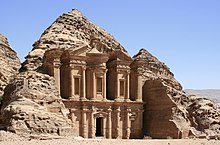
Petra, originally known to its inhabitants as Raqmu or Raqēmō, is a historic and archaeological city in southern Jordan. Famous for its rock-cut architecture and water conduit system, Petra is also called the "Rose City" because of the colour of the sandstone from which it is carved; it was famously called "a rose-red city half as old as time" in a poem of 1845 by John Burgon. It is adjacent to the mountain of Jabal Al-Madbah, in a basin surrounded by mountains forming the eastern flank of the Arabah valley running from the Dead Sea to the Gulf of Aqaba. Access to the city is through a famously picturesque 1.2-kilometre-long gorge called the Siq, which leads directly to the Khazneh.

As-Salt, also known as Salt, is an ancient trading city and administrative centre in west-central Jordan. It is on the old main highway leading from Amman to Jerusalem. Situated in the Balqa highland, about 790–1,100 metres above sea level, the city is built in the crook of three hills, close to the Jordan Valley. One of the three hills, Jabal al-Qal'a, is the site of a 13th-century ruined fortress. It is the capital of Balqa Governorate of Jordan.

Wadi Rum, known also as the Valley of the Moon, is a valley cut into the sandstone and granite rock in southern Jordan, near the border with Saudi Arabia and about 60 km (37 mi) to the east of the city of Aqaba. With an area of 720 km2 (280 sq mi) it is the largest wadi in Jordan.

The culture of Jordan is based on Arabic and Islamic elements. Jordan stands at the intersection of the three continents of the ancient world, lending it geographic and population diversity. Notable aspects of the culture include the traditional music and clothing of Jordan and interest in sports. These include football and basketball as well as other sports such as equestrianism, fencing, karate, swimming, and table tennis

Qasr Harrana, sometimes Qasr al-Kharana, Harana, Qasr al-Harrana, Qasr al-Haranah, Haraneh, Khauranee, or Hraneh, is one of the best-known of the desert castles located in present-day eastern Jordan, about 60 kilometres (37 mi) east of Amman and relatively close to the border with Saudi Arabia. It is uncertain when the palace was constructed, but it likely originates from the Umayyad Dynasty. An inscription on an upper wall dates the building to before 710 CE. A Greek or Byzantine house may have existed on the site. The purpose of the building is a subject of debate among scholars. Theories as to the qasr's purpose include a Crusader's castle, a military stronghold, agricultural outpost, and resting place for caravan travelers. The current scholarly consensus is that the building was used as for meeting between local Bedouin leaders.
The Royal Society for The Conservation of Nature (RSCN) is an independent voluntary organization that is devoted to the conservation of Jordan's natural resources; it was established in 1966 with the late King Hussein as Honorary President.
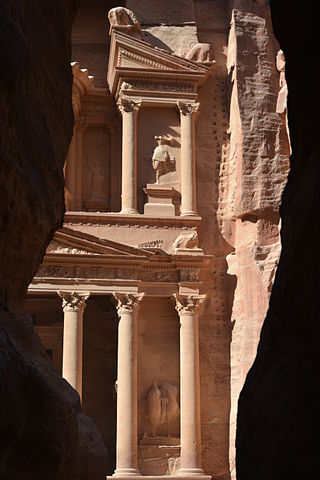
Al-Khazneh, akaKhazneh el-Far'oun, is one of the most elaborate rock-cut tombs in Petra, a city of the Nabatean Kingdom inhabited by the Arabs in ancient times. As with most of the other buildings in this ancient town, including the Monastery, this structure was carved out of a sandstone rock face.

The Siq is the main entrance to the ancient Nabatean city of Petra in southern Jordan. Also known as Siqit, it is a dim, narrow gorge and winds its way approximately 1.2 kilometres and ends at Petra's most elaborate ruin, Al Khazneh. A wide valley outside leading to the Siq is known as the Bab as-Sīq.
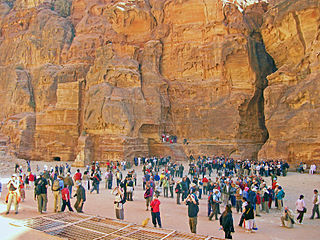
Jordan is a sovereign Arab state in the Middle East. The capital, Amman, is Jordan's most populous city as well as the country's economic, political and cultural centre.
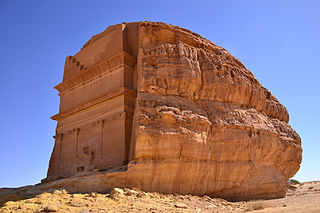
Hegra, known to Muslims as Al-Hijr, also known as Mada’in Salih, is an archaeological site located in the area of Al-'Ula within Medina Province in the Hejaz region, Saudi Arabia. A majority of the remains date from the Nabataean Kingdom. The site constitutes the kingdom's southernmost and second largest city after Petra, its capital city. Traces of Lihyanite and Roman occupation before and after the Nabatean rule, respectively, can also be found.

Free Palestine

The Zamani Project is part of the African Cultural Heritage Sites and Landscapes Database. Zamani is a research group at the University of Cape Town, which acquires, models, presents and manages spatial and other data from cultural heritage sites. The present focus of the Zamani project is Africa, with the principal objective of developing “The African Cultural Heritage Sites and Landscapes Database”. Zamani comes from the Swahili phrase “Hapo zamani za kale” which means “Once upon a time”, and can be used to mean 'the past'. The word is derived from Arabic root for temporal vocabulary, ‘Zaman,’ and appears in several languages around the world.

Ad Deir, also spelled ad-Dayr and el-Deir, is a monumental building carved out of rock in the ancient Jordanian city of Petra. The Deir was probably carved in the mid-first century AD.

Nabataean art is the art of the Nabataeans of North Arabia. They are known for finely-potted painted ceramics, which became dispersed among Greco-Roman world, as well as contributions to sculpture and Nabataean architecture. Nabataean art is most well known for the archaeological sites in Petra, specifically monuments such as Al Khazneh and Ad Deir.

Nabatean architecture refers to the building traditions of the Nabateans, an ancient Arab people who inhabited northern Arabia and the southern Levant. Their settlements—most prominently the assumed capital city of Raqmu —gave the name Nabatene to the Arabian borderland that stretched from the Euphrates to the Red Sea. Their architectural style is notable for its temples and tombs, most famously the ones found in Petra. The style appears to be a mix of Mesopotamian, Phoenician and Hellenistic influences modified to suit the Arab architectural taste. Petra, the capital of the kingdom of Nabatea, is as famous now as it was in the antiquity for its remarkable rock-cut tombs and temples. Most architectural Nabatean remains, dating from the 1st century BC to the 2nd century AD, are highly visible and well-preserved, with over 500 monuments in Petra, in modern-day Jordan, and 110 well preserved tombs set in the desert landscape of Hegra, now in modern-day Saudi Arabia. Much of the surviving architecture was carved out of rock cliffs, hence the columns do not actually support anything but are used for purely ornamental purposes. In addition to the most famous sites in Petra, there are also Nabatean complexes at Obodas (Avdat) and residential complexes at Mampsis (Kurnub) and a religious site of et-Tannur.

Little Petra, also known as Siq al-Barid, is an archaeological site located north of Petra and the town of Wadi Musa in the Ma'an Governorate of Jordan. Like Petra, it is a Nabataean site, with buildings carved into the walls of the sandstone canyons. As its name suggests, it is much smaller, consisting of three wider open areas connected by a 450-metre (1,480 ft) canyon. It is part of the Petra Archeological Park, though accessed separately, and included in Petra's inscription as a UNESCO World Heritage Site. It is often visited by tourists in conjunction with Petra itself, since it is free and usually less crowded.
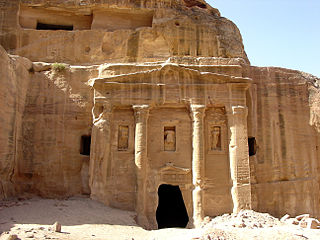
The Tomb of the Roman Soldier, also called the Tomb of the Soldier, is one of the best-preserved tombs in the ancient city of Petra, in what is now Jordan. Although its façade is its most recognizable feature — with three carved figures inset between columns — the tomb complex consists of several different architectural elements with varying degrees of preservation. In addition to the tomb façade, there is an associated courtyard, the remains of several two-story buildings, rock-cut rooms, a triclinium, and several large cisterns. The main building phase of the tomb complex took place during the third quarter of the 1st century AD.

The Palace Tomb is a Nabataean tomb in the Petra Archaeological Park. It is situated among the Royal Tombs, a line of prominent monumental facades on the east cliffs flanking the valley in which the city lies. At 49 meters wide and 46 meters tall, its rock-hewn façade is one of the largest in Petra. The tomb's name is derived from its supposed resemblance to a Roman palace design popularized by Nero's Golden House, as well as its wide and richly decorated structure... The descriptive name is based on its appearance today, rather than historical evidence for its use by royalty or occupation as a palace. The title “Palace Tomb” is recorded in the earliest catalog of tombs in Petra.

Ammar Khammash is a Jordanian architect, designer and artist. His work is based on the integration of building designs with nature and the surrounding environment. His projects helped revive Pella and Jordan Valley by creating two rest stops.

The Old Petra Museum is one of the archaeological museums in the city of Petra Jordan. It is located inside the natural rock within one of the Nabataean caves in Petra.


